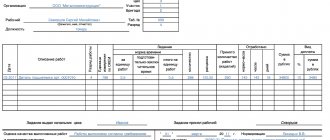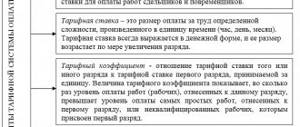Home / Labor Law / Payment and benefits / Wages
Back
Published: 03/07/2016
Reading time: 8 min
0
4260
One of the progressive and most modern forms of remuneration is commission. It allows you to establish a direct relationship between an employee’s salary and his work achievements, thus stimulating him to better results.
More details about the advantages and disadvantages of this system below.
- When and where is the commission system used?
- What factors does it depend on?
- Types of commission wages Commission-piecework
- Commission and bonus
Commission pay - what is it and when is it applied?
This system provides for the following: the amount of an employee’s salary depends on the percentage of revenue, which depends on the employee’s activities. That is, the system operates according to a simple formula: the funds received from the employee’s work are multiplied by a percentage of the revenue, the result of which will be a commission incentive for the employee’s work. This payment is made solely on the basis of an order written by the employer himself.
The legislative framework
Legislation is one of the most significant and effective regulators of commission remuneration. Let's look at the following table to see what documents are controlled by companies using this payment system:
| Title of the document | Regulatory Features |
| Constitution of the Russian Federation | According to the Constitution of the Russian Federation, every employee in the country has the right to receive the minimum wage. Following this rule, the employer is recommended to set the minimum salary for the employee, regardless of how much goods he can sell for the specified time period. |
| Labor Code of the Russian Federation | The Labor Code of the Russian Federation regulates commission wages in many respects. Firstly, according to Art. 135. According to the Labor Code of the Russian Federation, all conditions for making payments must be specified in official documents and provided to the employee before he takes up his position. Secondly, equal salaries must be assigned to all employees - that is, the established percentage must remain the same for each employee. And, finally, documentation establishing the specifics of paying wages on the territory of an individual enterprise should not contradict current legislation, incl. Labor Code of the Russian Federation. |
Failure by an employer to comply with the rules specified in the legislative framework of the Russian Federation may entail serious liability, even criminal liability.
Disadvantages of commission pay
The previously discussed advantages of this remuneration system are undeniable - but we should also look at its disadvantages. There are few of them, however, they can play a decisive role in choosing a given system:
- It is not profitable for an employer to set a minimum wage, because... sometimes it may be higher than what the employee actually deserves. The absence of a guaranteed minimum can scare away a potential employee, and sometimes lead to unforeseen negative circumstances.
- Sometimes a company needs to sell a product that is difficult to sell. A manager, realizing that he will not cope with the implementation (and, accordingly, will not receive a salary), may refuse to work with a high probability.
- The salary received does not always depend entirely on the employee.
Thus, the choice of this remuneration system is entirely individual. It may not be suitable for every employee or every employer.
Types of commission wages
The commission system, which itself is a type of mixed, is also divided into two types.
Commission and piecework
In this case, the employee’s salary depends entirely on his output and can be determined as:
- the product of the established percentage by the cost of products sold by the employee;
- the product of a fixed monetary amount and the volume of products sold (produced).
An example of calculation according to this scheme:
Salary of the seller Nakhimov A.I. depends on the sales volume of several types of products and is set as follows:
- 150 rub. from the sale of each electric kettle;
- 400 rub. from the sale of one multicooker;
- 700 rub. from the sale of a TV.
During the month the seller sold the following quantity of goods:
- 28 electric kettles;
- 18 multicookers;
- 14 TVs.
Nakhimov’s final salary will be:
Salary = 28 * 150 + 18 * 400 + 14 * 700 = = 21,200 rub.
Commission and bonus
In this case, the salary consists of two components:
- established salary (usually it is determined in the amount of the minimum wage);
- percentage of sales (represents additional payment, the so-called performance bonus).
The specific method depends on what goals the enterprise pursues and what kind of activity it is engaged in.
Example of salary calculation using the commission-bonus system:
- Her final salary will be:
- Salary = 900,000 * 7% + 8000 = 63,000 + 8000 = 71,000 rub.
- If the employee had not found a single buyer for the products, she would have received her minimum wage - 8,000 rubles.
Example of a commission-based remuneration system
As an example, we can consider the activities of the organization:
The employer sets the wage as a percentage of the cost of production that each employee produces in one month. Through calculations, the director of the organization calculates the total income of the enterprise from each employee. Thus, the salary of each employee will be calculated by multiplying income by a set percentage of the cost of goods.
The employer is obliged to pay the amounts received to his wards, and must not forget about the timely transfer of the advance and the remaining salary.
Where is the commission system of remuneration used?
The commission system of remuneration is suitable for the following types of enterprises:
- Enterprises that sell any kind of goods or services.
- An enterprise whose employees search and select clients for the future sale of goods or services to them.
- Firms that provide services to the public, place advertising brochures, sell goods, etc.
- Enterprises of foreign economic service.
- Enterprises of a non-productive nature that are engaged in entrepreneurial activities.
- Within various enterprises for the benefit of mid-level employees, managers, marketing employees, managers, advanced specialists, as well as executives.
In a market economy, it is the commission system of remuneration that becomes the most effective, profitable and convenient.
Examples of professions
As mentioned above, commissions are most popular in sales. However, sales is not the only place where this system is used.
Salaries are paid to employees by commission method:
- sales department;
- advertising agencies;
- foreign economic services;
- companies providing various services to the population;
- marketing departments;
- enterprises engaged in the sale of finished products;
- sales departments.
Comparison of the commission system of remuneration with others
Consider the following table to compare other commission-based compensation systems:
| Name of the remuneration system | Common and different features |
| Tariff (time-based) wage system | From a general point, it can be noted that it is quite easy to calculate such a salary for each individual employee - there is a special formula for this. If the tariff system operates with a bonus, then it, like the commission, becomes stimulating. Among the differences, we highlight that with a tariff system of remuneration, the final salary of an employee practically does not depend on how hard he works. Even if we take the tariff bonus payroll system, the bonus also does not always depend directly on the employee. |
| Piece wage system | Among the general features, let us separately highlight the fact that an employee’s salary directly depends on how much goods he produced or sold. Thus, the system is stimulating. Piece payment allows you to stimulate labor productivity, but most often collective rather than individual. In addition, there are many varieties of piecework wages, one of which is the piecework-bonus system. That is, ultimately the level of salary will be influenced by the employee’s productivity, which makes the system stimulating. One of the varieties of the piecework remuneration system is the lump-sum system: → When is the lump-sum remuneration system used in an organization? The differences mainly lie in the fact that wages are calculated on the team as a whole. It is quite difficult to distribute it between each participant: it is difficult to determine the individual contribution of each participant to the common cause. |
A suitable remuneration system is selected not only in accordance with the personal preferences of the director of the company, but also with the main type of activity of the enterprise, analysis of certain risks when selling a product or service, and other individual factors.
Regulations on remuneration on a commission basis - sample
The wage regulations are written only by the employer. It should include:
- name of the enterprise or organization;
- title("Order");
- date and order number;
- the main text of the document (about additional salary accruals - to whom and in what amount);
- employer's date and signature;
- signatures of workers familiar with the document.
It is important to note that before paying employees the appropriate funds, they must be familiar with the document and be sure to put their signatures there.
The essence of the commission payment system
The so-called commissions paid to employees within the framework of the described remuneration system are calculated in accordance with a certain proportion of the basic income of the employer. This system rightfully belongs to the stimulating system, since it ensures high performance even in rather harsh conditions.
Let's look at what the commission system of remuneration is:
- The employer determines the features of the commission system of remuneration (full, partial, mixed, with additions, etc.), as well as the interest rate, which can vary in accordance with the profile of the enterprise.
- This payment system is completely cost-effective and also satisfies all the economic conditions of the enterprise, since it is considered stimulating.
- The employer must inform the employee that the company has this form of remuneration during the interview, since this may not suit everyone.
- There are two main types of commission form - commission-bonus and commission-piecework. The first implies the presence of a minimum salary, on which commission interest is calculated, the second assumes only the accrual of interest without any minimum. Most often, the employer chooses exactly one of these systems without making adjustments or changes to it.
Many enterprises, in order to stimulate the work of their employees, are trying to either completely switch to this type of payment, or combine it with the currently valid form of payment.
How does the system work?
The commission system of remuneration is a type of piecework system and is a form of payroll in which the amount of an employee’s salary directly or indirectly depends on the turnover and revenue received by the employee.
Other types of piecework wages:
- straight>;
- piecework-bonus>;
- indirect piecework.
Commission remuneration is one of the types of a mixed system and is, in turn, divided into two types.
- Commission and bonus.
This means that wages include two components:
- salary (as a rule, it is the lowest salary);
- percentage of revenue (represents a bonus for good performance).
- Commission-based.
This means that wages directly depend on the employee’s output and are defined as:
- payment of a fixed monetary reward for a certain volume of goods (products) sold (manufactured);
- payment of an agreed percentage of revenue for products collected by an employee.
Depending on what exactly the company does and what goals it pursues, management chooses one payment method or another.
What does commission pay depend on?
In any case, no matter what kind of remuneration system the manager chooses, there are factors that influence the amount of wages. And each system has different these criteria. In the case of commission wages, this is:
- Volume of production. This concept may refer to the number of units of goods made.
- Type of product produced. It is not uncommon practice that for different types and types of goods a different percentage is established that will be accrued to the employee.
- Income received from production. This could be, for example, money transferred to the organization under the terms of a purchase and sale contract concluded by the manager.
- The level of consumer demand for a particular product.
- For seasonal goods at different times of the year, different accrued percentages may be established.
- The employee may be accrued a percentage based on the fulfillment of the established plan.
- The region in which production is located and where sales will be made also has a significant impact on the efficiency of work and its prices.
These and many other factors can directly or indirectly affect the level of wages. But the most important thing here is to indicate all these factors in the employment contract and write down exactly to what extent they affect the salary.
When a manager selects the required percentages for a commission system of remuneration, he establishes this in the following documents:
- In a position that directly relates to wages.
- In the decree for the enterprise, where all the exact figures will be indicated, as in the tariff schedule for tariff payment methods.
- In the text of the employment contract with the employee.
- In all other regulations that directly relate to the production process and remuneration.
And it is in the regulation that the head of the enterprise accepted and signed that not only the changed percentage is indicated, but also the factors that influenced this change. Both the percentage or numerical indicators themselves, as well as the criteria by which they will be calculated, must be specified there.
Formula for calculating salary on commission basis with example
When choosing a commission-based wage at an enterprise, you will need to specify in local regulatory documents a mechanism for calculating percentages on sales of goods/services. The best solution would be to indicate the formula by which the income of an employee or group of employees will subsequently be calculated.
Depending on the type of commission payment system chosen, different formulas for calculating wages are prescribed.
The universal formula for calculating an employee’s earnings on a commission basis (Zkot) will look like this:
Zkot = Vyr × K%,
Where:
Subscribe to our newsletter
Yandex.Zen VKontakte Telegram
Vyr - revenue from sales received by the enterprise as a result of the employee’s work, in rubles;
K% - commission interest rate.
Calculation example No. 1
In accordance with the terms of the employment contract, the head of the department for the sale of tools in the store of Sviristel LLC, P.S. Ivanchenkov, was given the following salary: salary in the amount of 8,000 rubles. plus a commission of 2.5% on sales revenue from his sales department No. 2.
In November 2021, revenue from the sale of goods in the Sviristel LLC store amounted to 1,000,200 rubles, including the department controlled by Ivanchenkov sold goods (tools) worth 840,000 rubles.
Thus, the salary of the head of the tool sales department, P. S. Ivanchenkov, in November 2021 was:
8,000 + 840,000 × 2.5% = 8,000 + 21,000 = 29,000 rub.
Calculation example No. 2
The sales manager of Phoenix JSC, O.P. Simakin, has been set a commission for labor in the amount of 10% of the proceeds for the products sold by him. In October 2017, Simakin sold products worth 80,000 rubles. (excluding VAT). At the same time, the employment contract with Simakin stipulates that the minimum monthly salary is 11,000 rubles.
So, wages for October 2021, according to the calculation, should have been:
80,000 × 10% = 8,000 rub.
In accordance with the fact that the actual monthly earnings are below the minimum specified in the employment contract, then for October 2021 O.P. Simakin will still be paid a salary of 11,000 rubles.
Calculation of remuneration according to the commission system
In general, the formula for calculating wages using the commission system looks like this:
Salary = V * %,
where B is the revenue that is received as a result of the employee’s activities, % is the established percentage of remuneration.
An example of calculating wages using this formula:
Sales Manager L.I. Davydova the employment contract establishes a salary of 15% of the cost of products sold by her. In February 2021, Davydova sold goods worth 180 thousand rubles.
For this month her salary will be:
Salary = 180,000 * 15% = 27,000 rub.
In this form, this system may not be attractive enough for the employee, since the amount of payment depends entirely on the level of sales.
If demand for a product drops or completely disappears, the employee may receive nothing at all.
Therefore, in some cases, the commission system is used with the establishment of a minimum salary, which the employee will receive in any case, regardless of performance results. In this case, the formula will be supplemented with a new element:
Salary = B * % + O,
where O is the employee’s fixed salary.
An example of calculation using this formula:
Product Sales Manager P.V. Kovalev works under an employment contract under the following conditions:
- minimum salary – 5000 rubles;
- part of sales proceeds – 20%.
In February 2021, Kovalev sold products worth 230 thousand rubles.
His final salary will be:
Salary = 230,000 * 20% + 5000 = 46,000 + 5000 = 51,000 rub.
Moreover, even if the employee did not sell anything, his 5,000 rubles. he should still get it. A variation of the fixed salary payment system is one in which the rate is not added to the employee, but is paid to him only in case of small sales. For example:
Seller Boyko I.P. sold products worth 15,000 rubles in March 2021. According to the employment contract, he has the right to receive:
- 20% of revenue;
- minimum bid of 12,000 rubles.
Since part of the proceeds is only 3,000 rubles. (15,000 * 20%), the employee will be paid his minimum fixed rate, that is, 12,000 rubles. In some cases, an increase in the percentage of revenue may be provided if the employee's sales volume exceeds the established limit.
The commission system of remuneration is quite popular in modern conditions, especially for enterprises that sell various goods and products. It allows you to establish a direct relationship between an employee’s salary and the revenue he brought to the company, thus stimulating him to maximum efficiency.
What is the maximum percentage for commission-based wages?
There is no specific maximum percentage of labor incentives and this is not stated in the Labor Code of the Russian Federation. This number can only be specified in the work contract between the employer and his ward. The only thing that can be noted is that the employer does not have the right to reduce the amount of wages that were received when calculated through a special formula - the product of the profit from the worker’s activities by a percentage of the number of sales.
Calculation example
As an example, the calculation of commission payments payable to the mid-level product sales manager of the Limited Liability Company “Chaika” Yu.D. is given. Kornilov.
According to the employment contract of Yu.D. Kornilov was assigned a salary using a minimum salary of 5,970 rubles, and a percentage of the products sold was set as commission payments equal to 12. For November 2021, Yu.D. Kornilov sold the products with a total cost of 95,000 rubles.
We determine the salary due to the manager using the formula: Due to Yu.D. Kornilov's salary for November is 17,370 rubles.
- In addition to the above, it should be noted that the problems of the remuneration system are key in the conditions of market relations between the employer and the employee.
- Productivity, which contributes to increasing the profitability of the enterprise, depends on wages.
- The employer should be interested in finding ways and methods of effective forms of remuneration for employees, on which the final result of the enterprise’s economic activity depends.
Example with commission-bonus
Initial data:
A sales manager working in a private company has a salary of 6,000 rubles, the percentage of revenue is 20%. In March 2021, the manager sold goods worth 220,000 rubles.
Calculation:
Let's calculate the employee's salary for March:
Salary = 220,000 * 20% +6000 = 50,000 rub.
Even if the employee did not make any sales, he would be guaranteed a salary of 6,000 rubles.
How to calculate wages?
To calculate the salary according to the commission-piece system, use the following formula:
Salary = V * %, where:
- B is the revenue received during the employee’s work process;
- % - percentage of revenue determined in advance.
This form of payment does not always attract employees, since earnings are determined by the number of products sold. In the event of a fall or complete absence of demand for products, the employee’s wages may be zero.
That is why quite often a commission-bonus form of payment is established, which implies that the employee is guaranteed to receive the agreed salary, regardless of the result of work. If there is a result of the labor process, a pre-agreed percentage is added to the salary.
The commission and bonus salary is calculated using the following formula:
ZP = B * % + O, where:
- O - employee salary.
Calculation example for commission-piecework form
Initial data:
The sales manager has a specified salary in his employment contract, the amount of which is 10% of the revenue for the goods he sold. In March 2021, the manager sold goods worth 170,000 rubles.
Calculation:
Let's calculate the manager's salary for January:
Salary = 170,000 * 10% = 17,000 rub.
Example with commission-bonus
Initial data:
A sales manager working in a private company has a salary of 6,000 rubles, the percentage of revenue is 20%. In March 2021, the manager sold goods worth 220,000 rubles.
Calculation:
Let's calculate the employee's salary for March:
Salary = 220,000 * 20% +6000 = 50,000 rub.
Even if the employee did not make any sales, he would be guaranteed a salary of 6,000 rubles.
In what cases is it used?
The essence of this type of payment is that the employee receives a fixed percentage of the revenue that the enterprise received due to the employee’s activities.
The most common application of the commission payment system is in sales. This allows not only to stimulate sales and turnover in general, but also to motivate employees to achieve greater results by increasing commission payments.
If it is necessary to increase the production volume of a product, this payment system is used at manufacturing enterprises.
In this case, a fixed surcharge is established for each manufactured unit of goods.
Examples of professions
As mentioned above, commissions are most popular in sales. However, sales is not the only place where this system is used.
Salaries are paid to employees by commission method:
- sales department;
- advertising agencies;
- foreign economic services;
- companies providing various services to the population;
- marketing departments;
- enterprises engaged in the sale of finished products;
- sales departments.
We specify in the employment contract the use of a commission system
When drawing up an agreement on working conditions and payment, the employer and employee must agree on all points of the contract. To reduce the risk of labor disputes arising from unresolved financial issues, it is necessary to stipulate in the employment contract:
- the amount of remuneration at the end of the month broken down by type of payment, that is, indicating the base salary (if any) and bonuses;
- factors on which the amount of the incentive portion of wages depends;
- conditions for payment of salary advances with fixation of their size;
- clarification of information on the calculation of payments in connection with vacation, temporary disability, indicating that their size does not depend on labor productivity.
In an employment contract, when describing the payroll scheme, you should not provide references to the Regulations on Remuneration or the staffing table. The employee does not have these documents and cannot review them at any time convenient for him. The trade union organization has the right to refuse to approve this version of the agreement.
Labor legislation does not regulate the maximum percentage for incentive bonuses. If desired, the employer can introduce a restriction and reflect this as a separate paragraph in the local documents of the enterprise. For the management of the organization, this is an additional opportunity to save on labor costs.
The decision to introduce a commission system of remuneration for all employees or a separate category of personnel is the prerogative of the employer. But it is worth remembering that all the nuances regarding the payroll mechanism must be reflected in the relevant local acts of the enterprise. And they will have to be agreed upon both with the trade union and with the employees themselves, so the approach to establishing the amount of incentive payments should be as objective as possible.
Areas of application and documentation of the commission system
The scope of application of different types of commission system of remuneration should be related to production or sales.
Remember! For a commission-based wage system to be approved, employees must be able to directly exert significant influence on sales or production.
An approximate list of areas in which it is advisable to use commission wages:
- trading enterprises;
- advertising agencies;
- sales services;
- marketing departments;
- production workshop workers;
- service sector.
The decision to establish a commission system of remuneration for some employees must be reflected in:
- regulations on wages;
- employment contract;
- employee hiring order;
- staffing table;
- collective agreement.
Do not forget! The standards set out in the Regulations on Remuneration must be previously agreed upon with the trade union or the body replacing it.
The establishment of a remuneration system in the Regulations is carried out by order of the head. Regulations on wages must be agreed upon with trade unions. The order on the wage system must contain the following information:
- Details of the organization indicating its location.
- Date of publication, order number.
- Information about the established method of remuneration.
- List of structural units for which a specific payment system is being introduced.
- Deadlines for introducing the appropriate form and payment system.
- List of company employees who are appointed responsible for documenting the Regulations and monitoring its implementation.
The order must be registered in the order register, assigned a registration number and familiarized with it under the signature of the responsible persons.
The employment contract discloses the issues of remuneration, salary amounts, and bonus conditions in as much detail as possible. The bonus system must be specified in the collective agreement. If it is necessary to make adjustments to the current wage system, a new order for amendments is issued, which, in addition to all mandatory details, indicates a list of documents affected by the innovation and the clauses in them with the wording of the corresponding changes.
Main features and nuances
This system has many unique features and characteristics, which are clearly reflected in the following table.
| Feature name | Content |
| Many forms of establishing commission amounts | Among these forms, several of the most frequently used ones can be identified:
|
| Compatibility | This payment system can act as an independent one or serve as an addition to another system. For example, a combination is often encountered when an employee is assigned a fixed salary, to which, based on work results, a percentage of the work performed is added. |
| Stimulation | For many employees, the commission system of remuneration serves as a good incentive for more active sales and increased sales volumes. |
| Mutual benefit | Such a remuneration system is beneficial not only for the employee as a reliable incentive, but also for the employer. It is beneficial for the director of an enterprise if he pays less to someone who has worked little in a month, since this is fair. The result of the work can also be clearly monitored. |
| Openness of regulatory documentation | Documents regulating wages within the company must be publicly available to any employee. They must include information such as bonus conditions (if any); the number of employees receiving salaries according to the specified scheme; the amounts and timing of these payments. |
Among the features, in most cases only positive features can be noted - therefore, recently there are more and more adherents of this particular remuneration system.
Advantages and disadvantages
The benefits of the commission system for the employee include:
- the ability to independently plan working hours and expected earnings;
- flexibility in choosing methods and work schedule;
- the presence of motivation to work on constantly improving the level of professional skills, which makes it possible to increase one’s competitiveness in the labor market.
Disadvantages for employees:
- frequent refusal of employers to introduce a fixed minimum salary, which could be received even in the absence of positive sales dynamics;
- dependence of labor results on the brand and characteristics of the products sold;
- the possibility of a lack of new business due to current negative trends in the financial or political sectors;
- lack of material stability.
The benefits for employers come down to the presence of a strong motivational factor and the opportunity to save on labor costs at a low level of sales. An additional advantage is the promotion of certain categories of goods at a faster pace by establishing increased premiums for transactions on them.
The negative side is the need to thoroughly study the legal issues of introducing a commission system to reduce the likelihood of unscheduled inspections by the labor inspectorate and prevent labor disputes.
Answers to frequently asked questions
Question No. 1 . Can the commission system of remuneration be used in enterprises that are not involved in the sale or distribution of goods and services?
In the current economy, this option in many cases turns out to be convenient for both the employer and the employee. However, if it turns out to be impossible or difficult to find out for sure the level of profit that an employee brought, then such a payment system can be combined with another.
Question number 2 . Can an employer change the predetermined commission percentage?
Yes, but for this he will need to obtain the consent of all other management officials at the enterprise, issue an order, and also be sure to familiarize the employee with the changes, having received a receipt from him for familiarization.
Question number 3 . If the company operates a commission system of remuneration with a set minimum income, which the employee did not earn in a month, what salary will he receive?
In accordance with the Constitution of the Russian Federation, an employee will still have to receive the established minimum, even if he has not earned it in a month (see → minimum wage by year).
Question number 4 . Can an employer change the established minimum wage at the enterprise (base rate)?
Yes, it can, but in order to do this, he will need to obtain consent from other management officials at the enterprise, issue an order and be sure to introduce it to all employees who will be affected by this issue.
Commission (bonus) system of remuneration of employees
The commission (bonus) system is one of the most common flexible remuneration systems and is used in organizations of various forms of ownership, incl. and state.
Most often, such a remuneration system is used in production, trade, and also in the service sector.
The popularity of the use of the commission system by employers is due to its effectiveness in stimulating labor, as well as the simple scheme for calculating employee wages.
In its simplest form, the commission system involves the employee's earnings as a percentage of the volume of sales he makes. In this case, the percentage can be either fixed or variable depending on the result of the work.
In the media, such a remuneration system is sometimes called “bonus”, but the term “commission system” has been adopted in Belarusian labor legislation.
The entire set of varieties of commission forms of remuneration can be divided into two types: commission-bonus (salary + interest) and commission-piecework (only percentages from the sale of goods, works, services by a specific employee, established by local regulatory legal acts).
At the same time, a distinctive feature of the commission-bonus form of remuneration is the relatively low amount of the basic part of remuneration (salary) and the potentially high amount of the variable part of wages (commission payments).
It must be taken into account that if an employee has fully worked the standard hours established for him, his salary cannot be less than the established minimum wage in the Republic of Belarus.
According to the Resolution of the Council of Ministers of the Republic of Belarus dated December 28, 2017 No. 1022 “On establishing the monthly minimum wage,” from January 1, 2021, the monthly minimum wage is set at 305 rubles.
The commission system of remuneration, like any other, has its pros and cons.
The main advantage of such a remuneration system is a transparent and understandable motivation system for every employee. It is easy to tune an employee to a specific result of increasing sales volumes (goods, services). With such a remuneration system, an employee can achieve an increase in wages in the short term, because The amount of remuneration largely depends on his work.
Among the disadvantages, the most significant is the lack of stability in wages.
With a commission system of remuneration, sales indicators for products (services) or production may depend not only on the employee’s labor contribution, but also on many other factors, among which are:
- seasonality;
- increasing the activity of competing organizations;
- nuances of interaction with partner organizations;
- changes in market conditions, etc.
Employees who are accustomed to stable wages may not be ready for a bonus wage system.
With such a remuneration system, it is sometimes difficult to plan for large long-term financial expenses, such as paying off loans.
The definition of the term “commission system of remuneration” is given in the Recommendations on the application of the commission system of remuneration for employees of commercial organizations (hereinafter referred to as the Recommendations), approved by Resolution of the Ministry of Labor and Social Protection of the Republic of Belarus dated March 31, 2014 No. 17.
According to the Recommendations, a commission remuneration system is a remuneration system in which the amount of workers’ wages is directly dependent on the growth in volumes of products sold, goods (works, services), incl. for export, reduction of finished product inventories and foreign exchange earnings and other indicators characterizing the efficiency of the division and (or) the organization as a whole.
A commission is a payment to an employee in a certain proportion of the income he brings to the organization. The simplest version of the commission system of remuneration - a fixed percentage of goods sold, is probably familiar to the vast majority of small business organizations involved in trade.
Let's look at the most common and popular commission payment systems among employers.
1. Commission system of remuneration with a fixed percentage, without establishing a tariff part
Such a flexible system of labor incentives is most relevant for organizations involved in the sale of goods (works, services), as well as for remuneration of employees whose responsibility is to find customers and sell goods and services to them. The choice of a specific type of commission system depends on the goal pursued by the organization, as well as on the characteristics of the product being sold, the specifics of the market and other factors.
The advantages of such a remuneration system are the direct dependence of the amount of accrued wages on the performance of a particular employee and the simplicity of wage calculation.
An employee's salary is calculated using the formula:
Revenue received as a result of the Percentage established by the Salary.
employee work × revenue =
The employee is assigned a specific fixed percentage of the sales volume of goods (works, services).
For example, revenue from the sale of goods by an employee for the month amounted to 10,000 rubles. According to the employer’s local regulatory legal acts, the employee’s wages are set at 8% of revenue based on the results of the calendar month.
The employee's salary will be:
10,000 × 8% = 800 rub.
Read the continuation of the article after purchasing paid access to the portal!
conclusions
The commission system of payment for labor is very popular today. The greatest application of this system is in enterprises engaged in the sale of a variety of goods and products.
Commission remuneration establishes a direct relationship between the employee’s salary and the results of his activities, thereby motivating the employee to be more active in order to achieve maximum efficiency.
Sources
- https://russiansu.ru/zarplata/sistema-oplaty-truda-na-komissionnoj-osnove.html
- https://online-buhuchet.ru/komissionnaya-sistema-oplaty-truda/
- https://okarb.ru/kadrovyj-uchet/komissionnaya-sistema-oplaty-truda-chto-eto.html
- https://zakonguru.com/trudovoe/oplata/zarplata/komissionnaya-oplata-truda.html
- https://azbukaprav.com/trudovoe-pravo/zarplata/sistemy-oplata-truda/komissionnaya.html
- https://sovetkadrovika.ru/organizaciya-biznesa/kadry/oplata-truda/komissionnaya-oplata-truda.html
- https://assistentus.ru/oplata-truda/komissionnaja/











